Mastering Brutalist Interior Design: A Comprehensive Guide to Raw, Modern Aesthetics
Brutalist interior design is a captivating style that brings clean lines, robust forms, and an unapologetic honesty to modern homes. Rooted in an architectural movement, this aesthetic celebrates raw materials like concrete, steel, and glass, often showcasing them in their unrefined state. It’s a look that challenges traditional notions of warmth and comfort, instead offering a powerful, sculptural, and inherently durable approach to living spaces.
This guide delves deep into what makes brutalist design truly special and how its principles are artfully applied in contemporary residences. We’ll journey through its fascinating history, identify its foundational features, and, most importantly, provide actionable strategies to infuse your home with this distinctive character, even making concrete-heavy spaces feel inviting and lived-in.
Whether you’re looking to undertake a major renovation or simply add subtle brutalist touches, we’ll explore room-by-room inspiration and practical advice suitable for various spaces and budgets. Prepare to discover how this strong, simple, and enduring style can create environments that are not only visually striking but also incredibly functional and resilient.
Understanding Brutalist Interior Design: Origins, Materials, and Traits
To truly appreciate brutalist interior design, it’s essential to grasp its foundational principles, which stem directly from its architectural predecessor. This section explores the origins, key materials, and core traits that define this powerful aesthetic.
Origin from Brutalist Architecture
Brutalist interior design directly descends from the brutalist architectural movement, which flourished primarily from the 1950s to the 1970s. The term “Brutalism” itself is derived from the French phrase “béton brut,” meaning “raw concrete,” famously used by the Swiss-French architect Le Corbusier to describe the unfinished concrete surfaces he favored in his buildings. Born in the aftermath of World War II, when resources were scarce and the need for functional, economical construction was paramount, Brutalism emphasized utilitarianism and the honest expression of structural materials.
Initially, it was a practical and philosophical response to the perceived excesses of earlier, more decorative styles. Buildings of this era—including many government institutions, universities, and public housing projects—were characterized by their massive, monolithic forms, often made from exposed concrete, demonstrating a deliberate rejection of ornamentation in favor of raw structural honesty. This architectural philosophy naturally extended to interiors, influencing how spaces were conceived and furnished.
Key Materials of Brutalist Design
The material palette of brutalist design is deliberately restrained, focusing on a few core elements chosen for their strength, texture, and intrinsic beauty. These materials are rarely disguised or embellished, instead celebrated for their natural qualities.
- Concrete: Undeniably the star material, concrete in brutalist design is often left in its raw, unfinished state. This can manifest as smooth, polished concrete floors, rough, textured walls (sometimes with visible formwork marks), or solid, sculptural furniture pieces. Its natural gray tones provide a neutral backdrop, while its varied textures add depth and tactile interest. Beyond aesthetics, concrete offers incredible durability and thermal mass, contributing to sustainable interior environments.
- Steel: Steel plays a crucial role in brutalist interiors, offering both structural integrity and a distinct industrial edge. It appears in exposed beams, window frames, staircases, and various fixtures. Often left unpainted or brushed, steel’s metallic sheen provides a cool contrast to concrete, reinforcing the style’s functional and robust character.
- Glass: While brutalist structures can sometimes appear imposing, glass is essential for mitigating this heaviness by inviting light and visual connection. Large windows and glass partitions prevent spaces from feeling overly enclosed or dark, creating a sense of openness and allowing the stark beauty of the interiors to be illuminated by natural light.
- Wood (often reclaimed): Although less prominent than concrete and steel, wood, particularly reclaimed or minimally finished timber, is often introduced to add warmth and organic texture, softening the otherwise stark environment.
Core Traits of Brutalist Interiors
The philosophy of brutalist design is distilled into several core traits that dictate its aesthetic and functional approach:
- Minimalist: Brutalism embraces minimalism, stripping away non-essential elements to focus on fundamental forms and purposeful design. Clutter is avoided, allowing each object and structural element to command attention.
- Blocky & Monolithic: Designs often feature strong, geometric shapes and solid, heavy forms. Furniture is typically substantial and angular, contributing to an overall sense of permanence and monumental presence.
- Raw & Honest: Materials are presented in their natural, unadorned state, celebrating their inherent textures and imperfections. There’s no attempt to hide construction methods; instead, they are often highlighted as part of the design.
- Useful & Functional: Functionality is paramount. Every design choice serves a practical purpose, with form following function. The aesthetic emerges from the solution to practical needs rather than applied decoration.
- Sculptural: Due to its emphasis on strong forms and raw materials, brutalist interiors often possess a sculptural quality, where spaces and objects interact like pieces of art.
A Practical Guide to Incorporating Brutalist Interior Design in Your Home
Embracing brutalist design doesn’t require living in a concrete bunker. You can subtly or boldly integrate this powerful aesthetic into your existing home. Here are eleven practical ways to start.
1. Embrace Concrete Elements
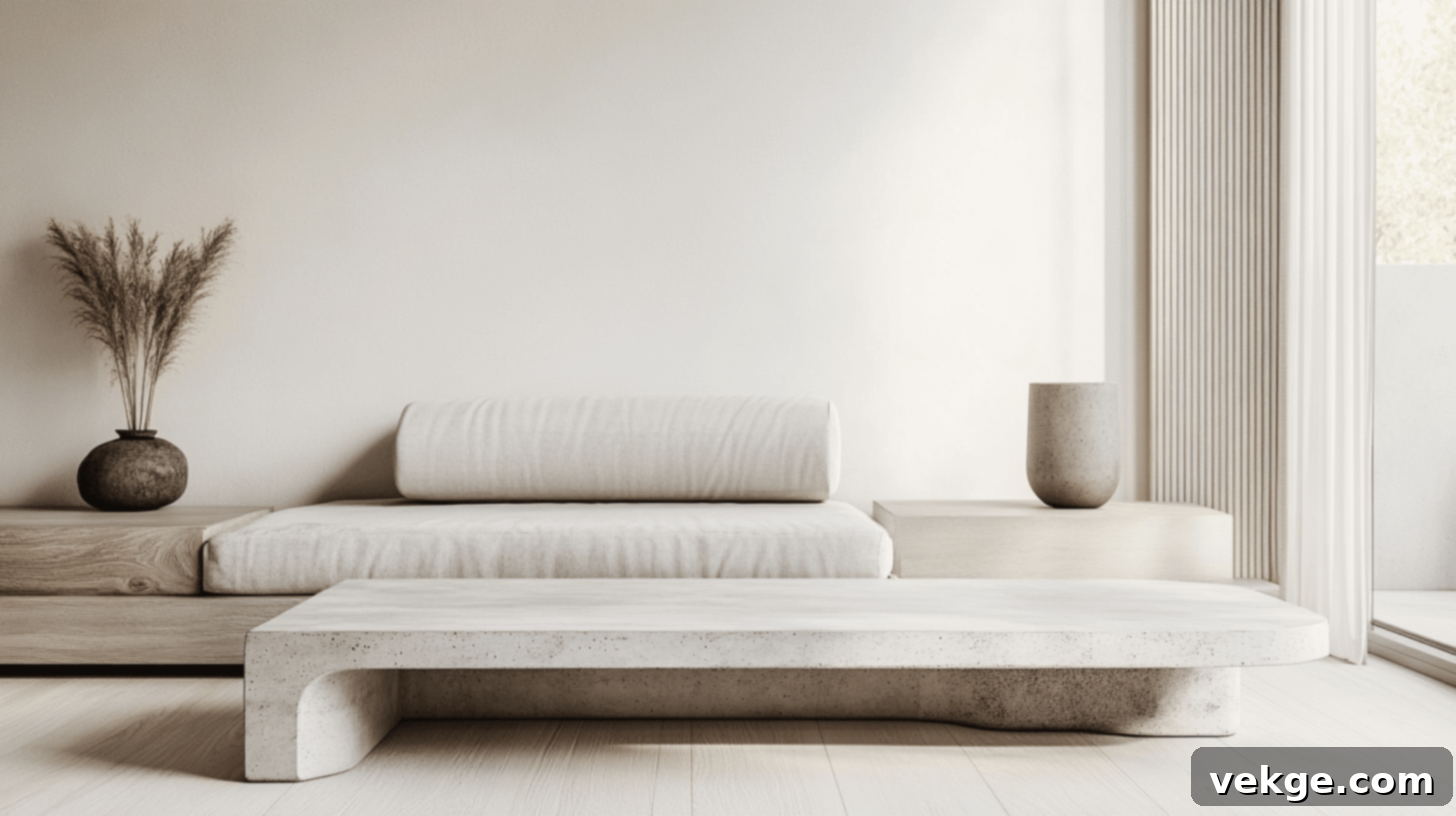
Concrete is the undeniable hero of brutalist design. Start by introducing smaller, impactful concrete items such as a substantial coffee table, a minimalist kitchen counter, or even a sleek, industrial-style side table. For a more significant transformation, consider investing in polished concrete floors, which offer durability and a seamless aesthetic, or designating a single concrete feature wall to create a powerful focal point. If you’re a beginner or renter, smaller concrete accessories like plant pots, sculptural lamp bases, or decorative trays are excellent, low-commitment ways to introduce the material’s unique texture and gravitas.
2. Choose Blocky and Substantial Furniture
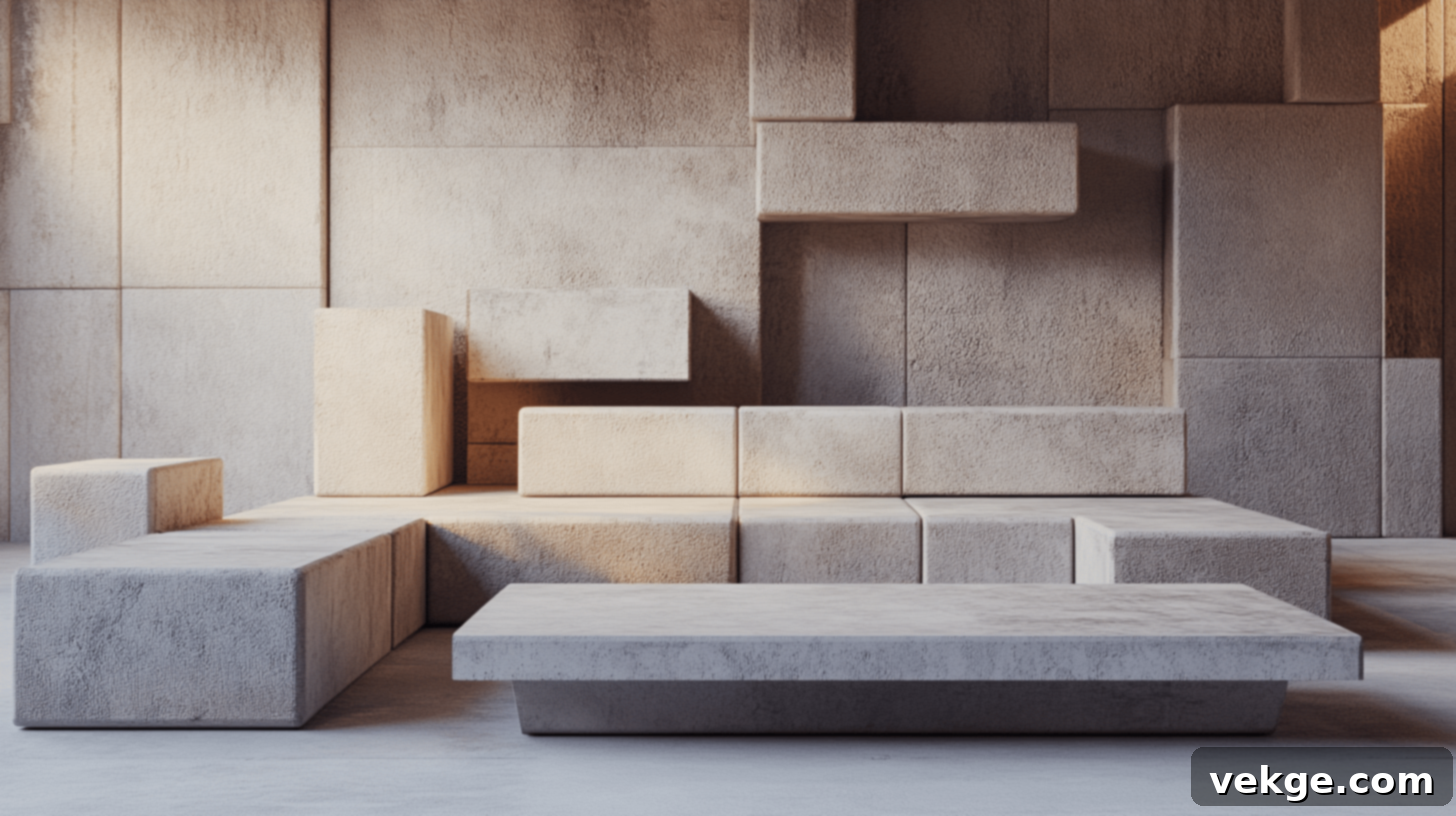
Brutalist furniture is defined by its strong, clear, and often imposing shapes, devoid of frivolous ornamentation. Look for sofas with rigid straight lines, exposed frames, and solid, perhaps even visible, legs. Tables, whether dining, coffee, or side tables, should feature thick tops and robust bases, embodying a sense of unwavering solidity. Prioritize heavy, chunky pieces over delicate, slender ones to achieve the desired impact. The essence lies in selecting items that look and feel honest, straightforward, and built to last, often appearing as though they were sculpted rather than merely assembled.
3. Stick to a Neutral Color Palette
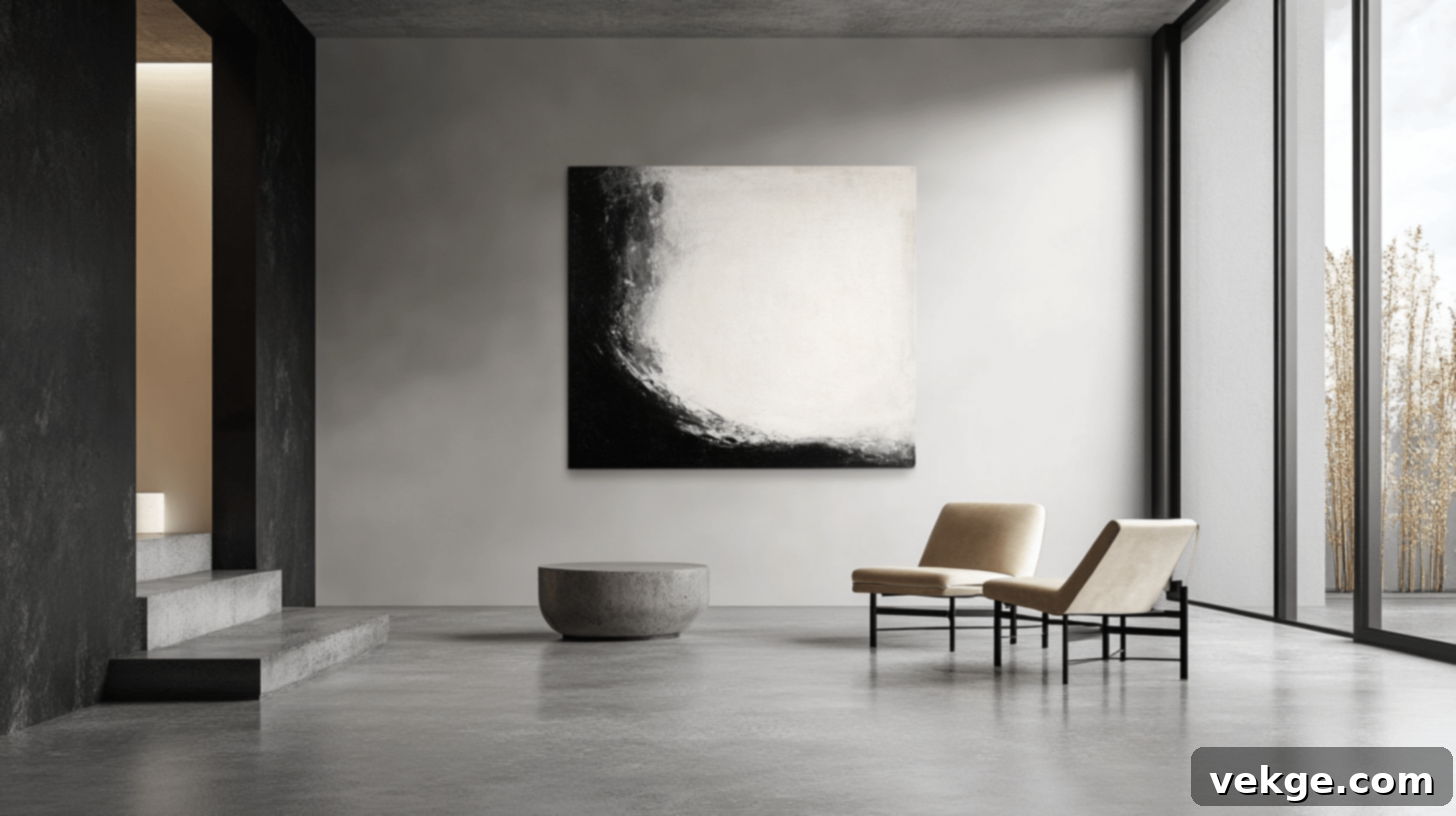
Brutalist spaces thrive on a minimalist color scheme. Dominant hues typically include shades of gray, stark white, deep black, and warm beige. These neutral tones are not merely backgrounds; they actively enhance the raw textures of concrete, the cool sheen of metal, and the earthy grains of wood. This palette creates a calm, sophisticated foundation that allows the strong architectural forms and sculptural furniture to truly stand out. If you desire to introduce color, do so sparingly and thoughtfully, perhaps through a single piece of art, a vibrant plant, or a small textile accent, rather than overwhelming entire walls or large surfaces.
4. Incorporate Steel Fixtures and Accents

Steel is integral to achieving the raw, industrial edge that complements brutalism so well. Integrate steel through furniture elements like table legs, chair frames, or shelving units. Brushed steel often offers a softer, more refined industrial look compared to high-gloss chrome, harmonizing better with raw concrete. Statement pieces such as open steel shelving units, characterized by their clean lines and visible construction, offer both practical storage and a sculptural presence. Even minor details, like steel drawer pulls or cabinet hardware, can contribute significantly to the overall aesthetic.
5. Expose Structural Elements
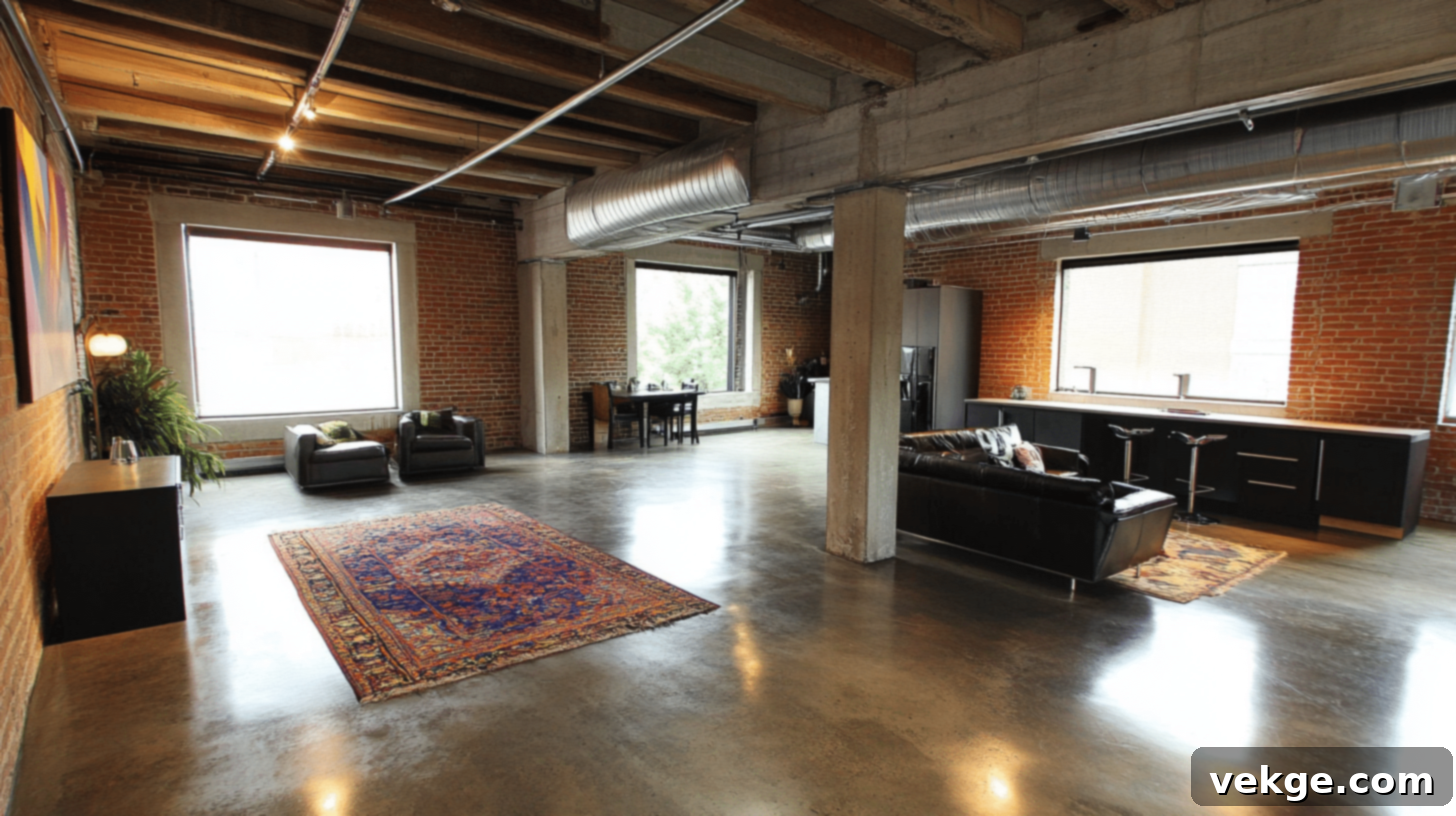
A fundamental tenet of true brutalism is the honest exposure of a building’s structure, rather than concealing it. If your home permits, consider revealing architectural elements such as concrete columns, overhead ceiling beams, or even original brick walls. Removing false ceilings can expose ductwork or electrical conduits, transforming utilitarian elements into aesthetic features. Stripping back wall coverings to reveal the underlying material, be it concrete or rough plaster, adds immense character and a sense of architectural truth to your space, celebrating the raw bones of your home.
6. Mix in Reclaimed or Raw Wood
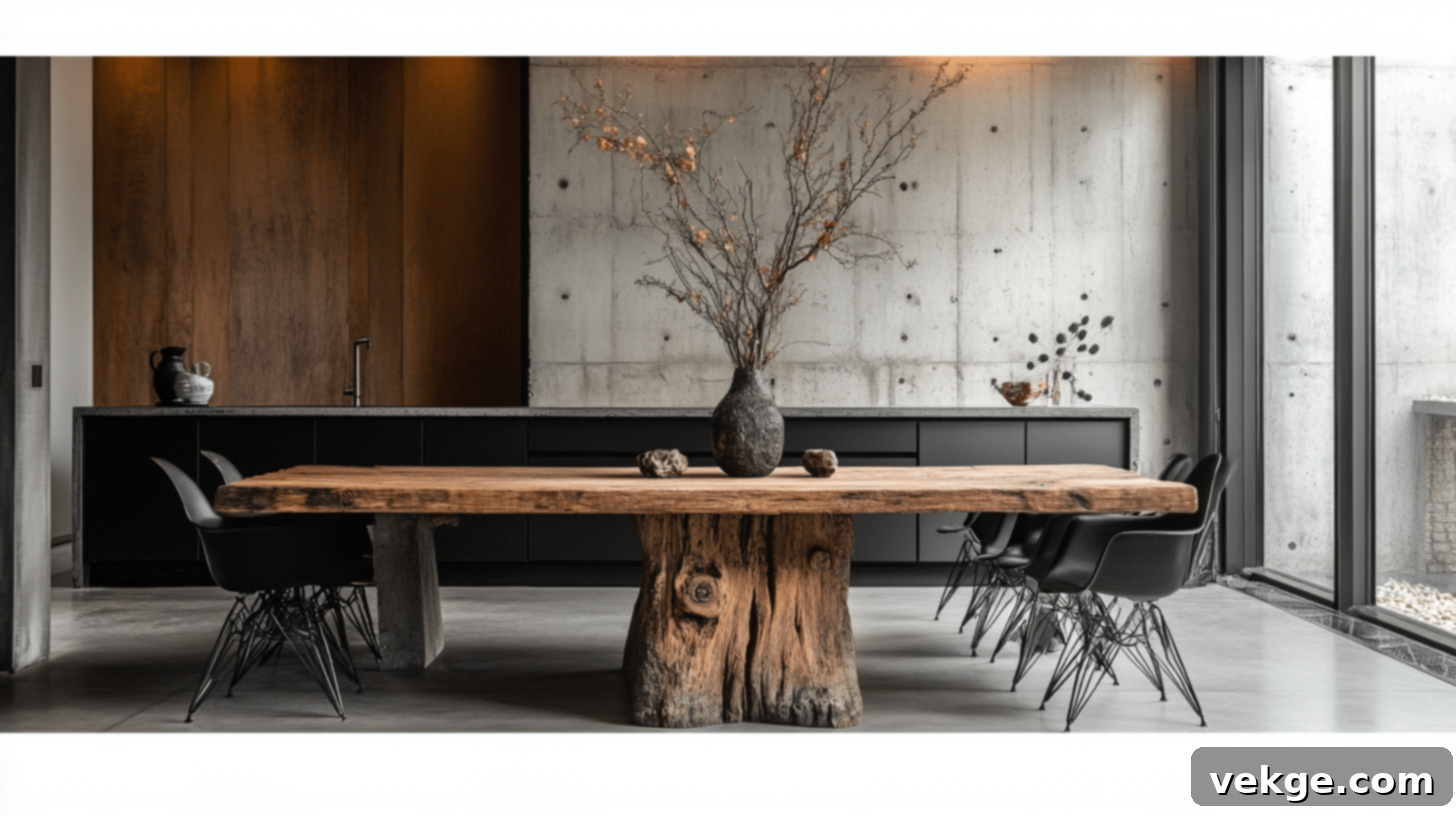
To counteract the inherent coolness of concrete and steel, strategically introduce the warmth and organic texture of wood. Opt for substantial, chunky wooden tables, benches, or shelves characterized by their simple, unadorned shapes. Reclaimed wood, with its visible grain, knots, and history, is particularly well-suited, as its imperfections align perfectly with the honest, raw nature of brutalism. Even a single well-placed wooden element can soften a room’s atmosphere without compromising the strong, minimalist style, creating a vital balance between hardness and natural warmth.
7. Maintain a Minimalist Layout
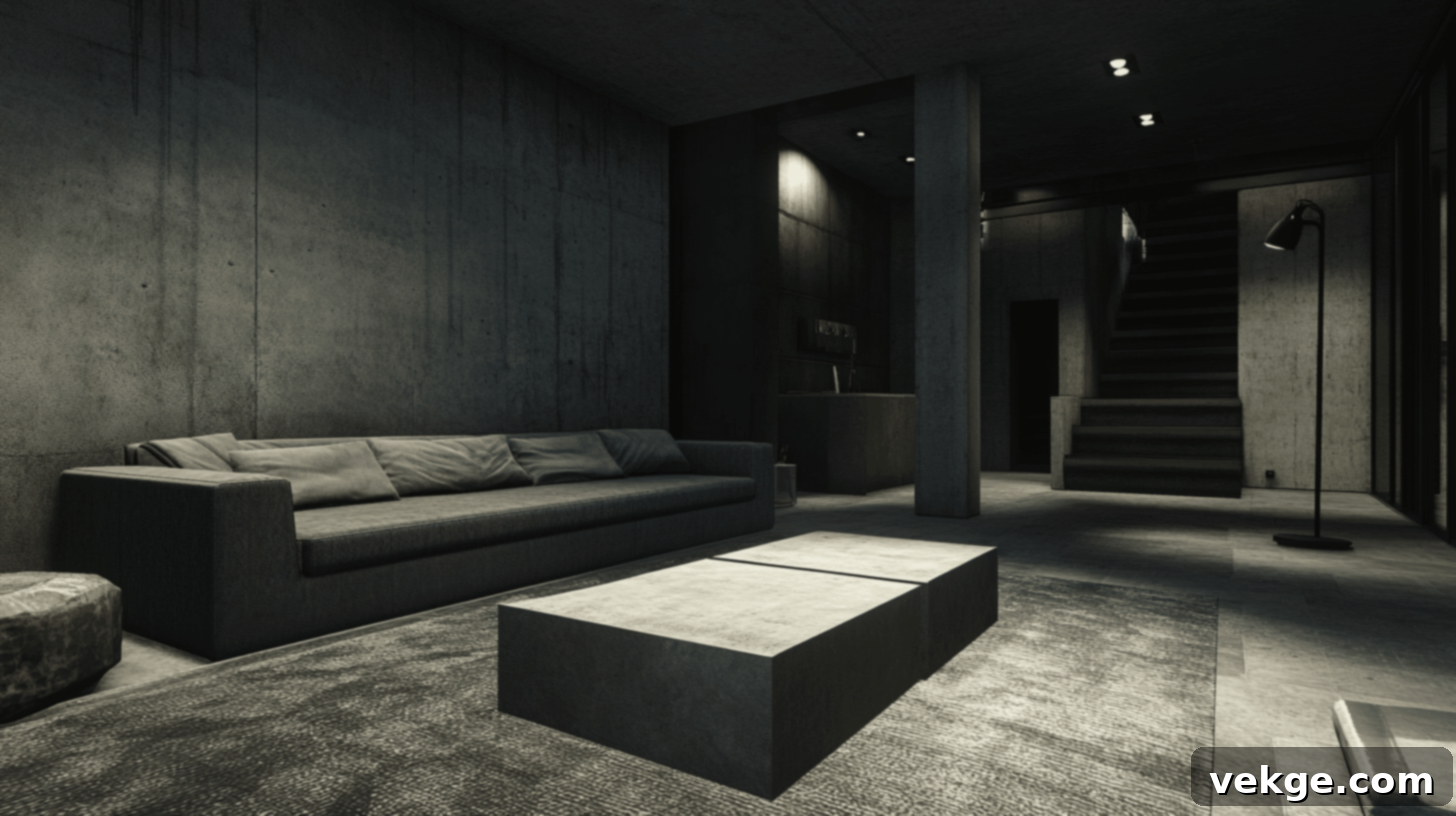
Brutalist interiors demand ample space to allow their powerful forms and rich material textures to be fully appreciated. Embrace a philosophy of “less is more,” keeping only items that are genuinely needed, functional, or hold significant aesthetic value. Avoid excessive small decorations or clutter, which can create visual noise and distract from the impactful elements. Each piece of furniture or decor should have sufficient breathing room to stand on its own as a sculptural object. This open, uncluttered approach not only makes rooms feel more expansive but also allows the distinct brutalist features to truly shine.
8. Layer Soft Textiles Thoughtfully
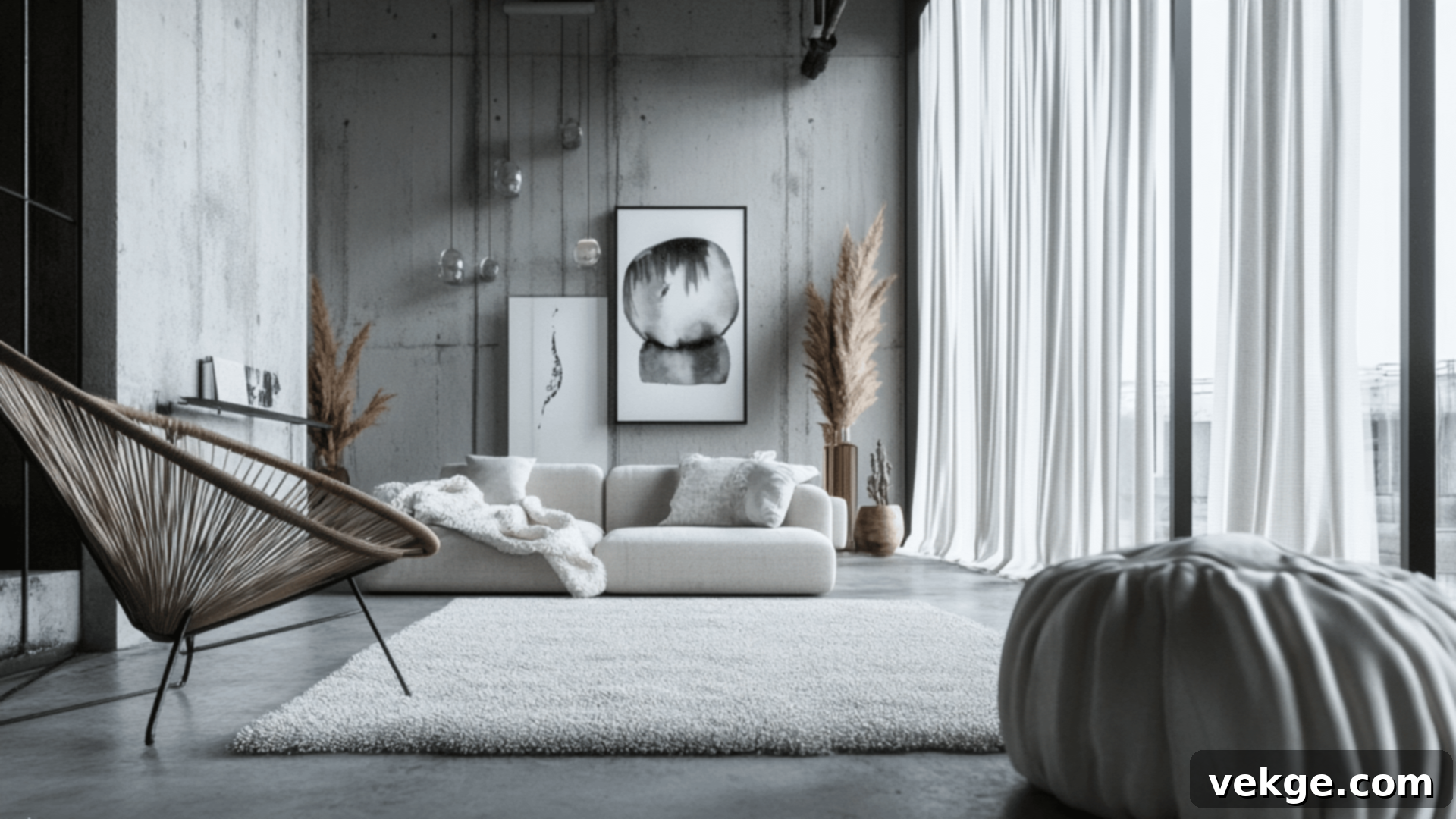
To prevent brutalist spaces from feeling overly cold or austere, strategically layer soft textiles. A thick, textured wool or jute rug can instantly warm up hard concrete floors, providing comfort underfoot and absorbing sound. Drape simple, natural fiber throws—such as linen or chunky cotton—over chairs and sofas. Choose cushions in solid, muted colors or subtle geometric patterns that complement the overall neutral palette. These carefully chosen soft elements introduce tactile warmth and comfort, making brutalist rooms feel more inviting and livable without compromising the strong underlying aesthetic.
9. Opt for Statement Lighting
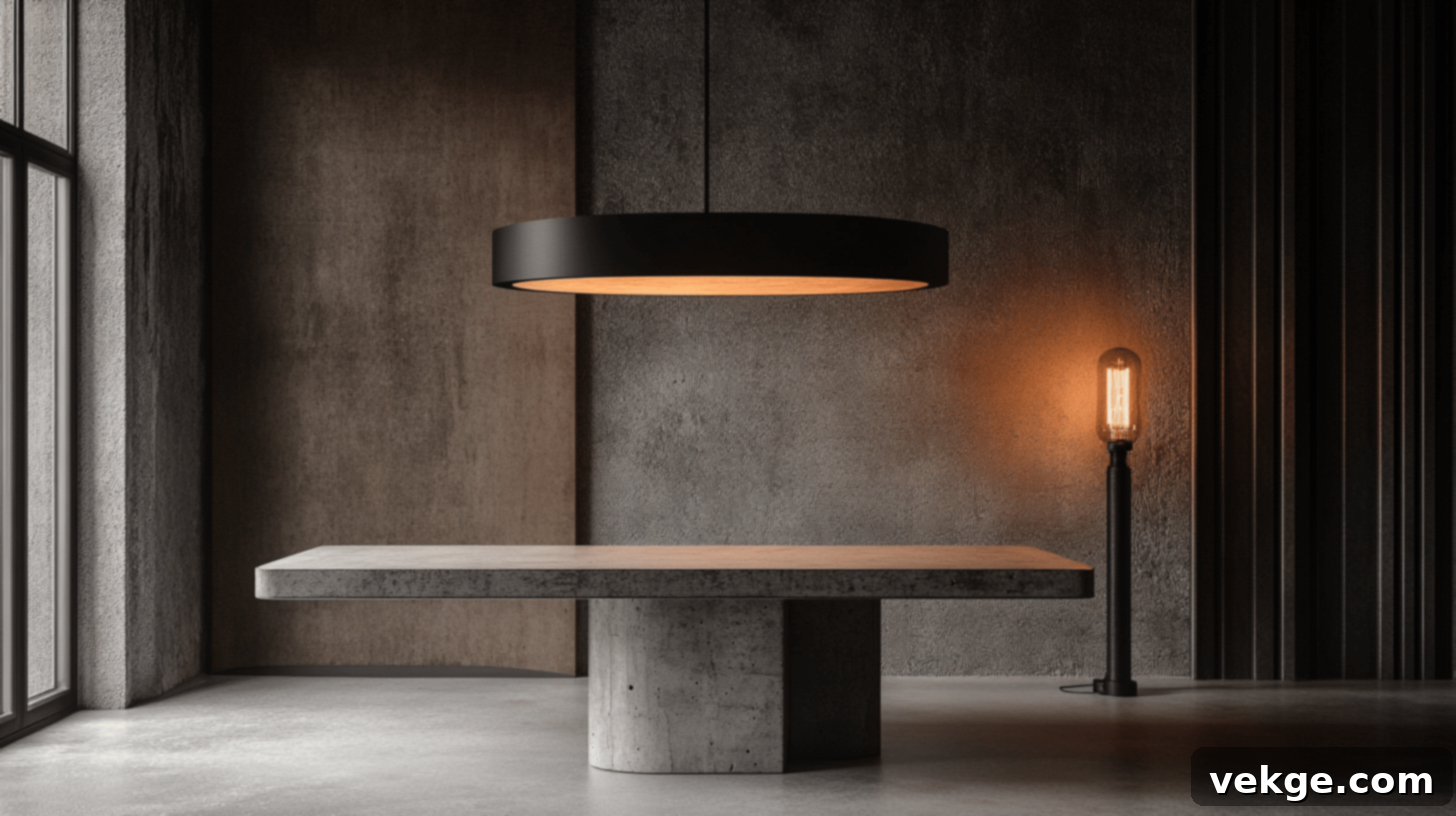
Lighting is crucial for shaping the mood and emphasizing the forms within a brutalist space. Choose fixtures that are sculptural and impactful. Large pendant lights with simple, geometric shades—made from concrete, metal, or even unadorned glass—draw the eye upwards and serve as focal points. Floor lamps featuring concrete bases and steel stems perfectly align with the style. Avoid ornate or overly decorative fixtures; instead, embrace minimalism. Exposed bulbs, particularly vintage Edison-style filaments, enhance the raw, honest, and utilitarian aspect of the brutalist approach, adding a touch of industrial charm.
10. Introduce Green Plants
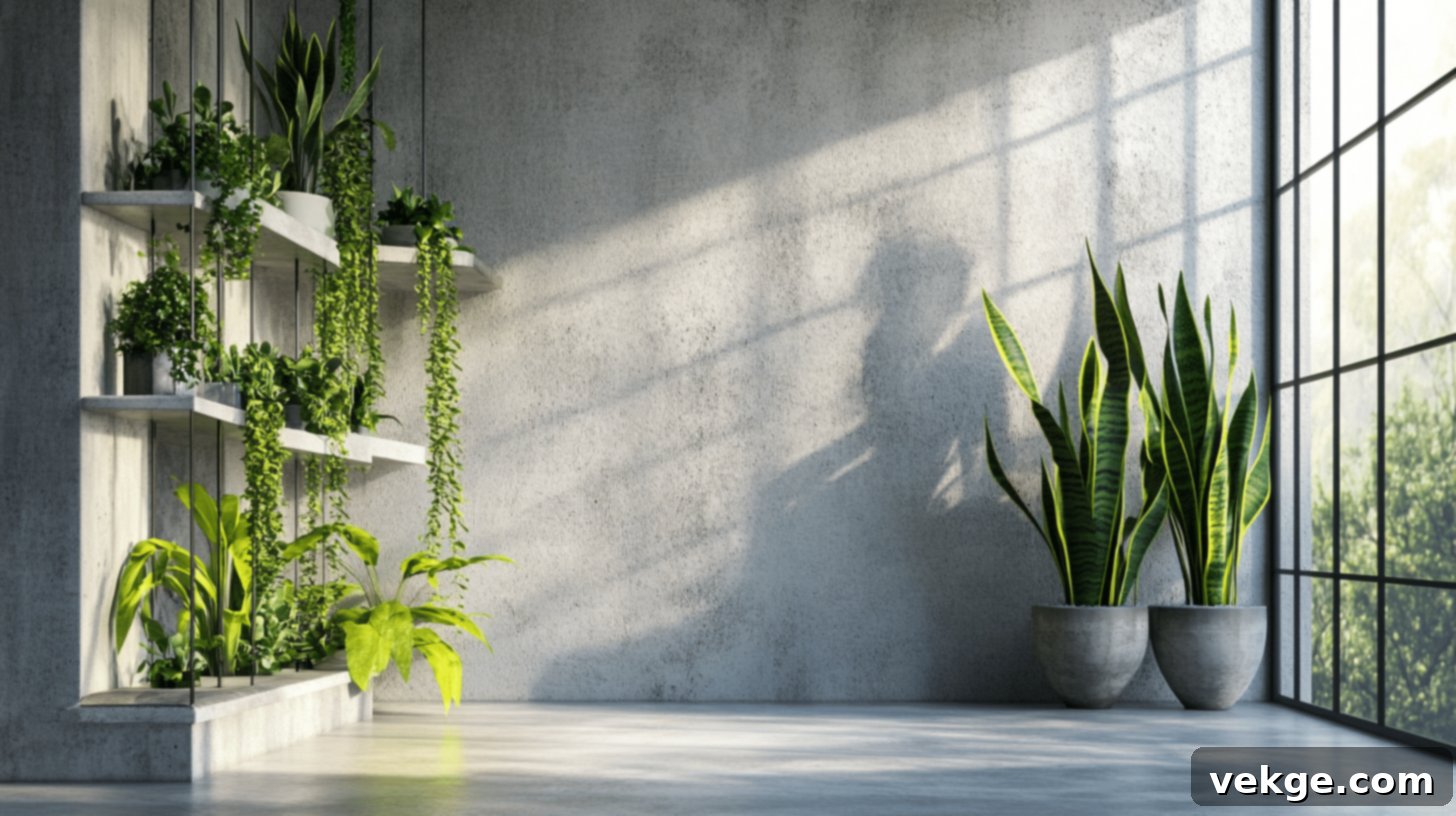
Plants are vital for injecting life, organic form, and a refreshing contrast into brutalist environments. Tall, architectural plants with strong vertical lines, such as snake plants (Sansevieria), ZZ plants, or fiddle-leaf figs, beautifully echo the geometric precision of the style. Trailing plants like Pothos or Philodendron can soften hard edges when placed on high shelves or cascading from concrete planters. The vibrant green foliage provides a natural pop of color against the grays of concrete and metals, adding a fresh, dynamic element to rooms that might otherwise feel static or overly monochromatic.
11. Explore Faux Concrete Finishes
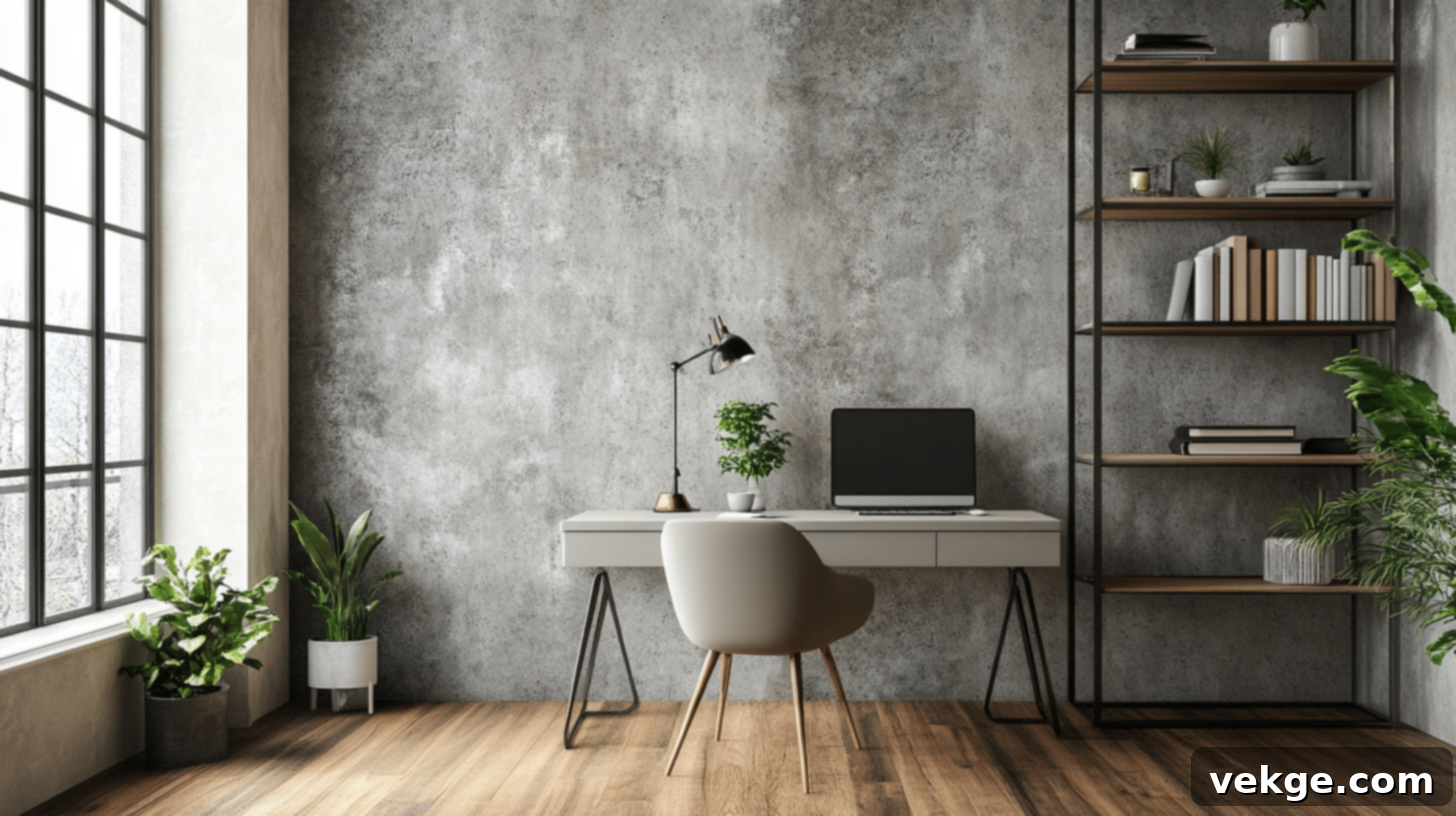
If you’re not ready or able to commit to real concrete construction, faux finishes offer an excellent alternative to achieve the brutalist look. High-quality concrete-look wallpaper can create a realistic illusion on walls without the weight, cost, or permanence of actual concrete. Specialized painting techniques, such as micro-cement or polished plaster, can also replicate the appearance and texture of concrete on regular walls, offering a versatile and customizable solution. Additionally, many furniture pieces are now available with concrete-look tops or finishes, allowing you to integrate the style without the substantial heft of solid concrete items.
Brutalist Interior Design: Room-by-Room Inspiration
Applying brutalist principles can transform any room into a striking and functional space. Here’s how to adapt the style for different areas of your home.
Living Room
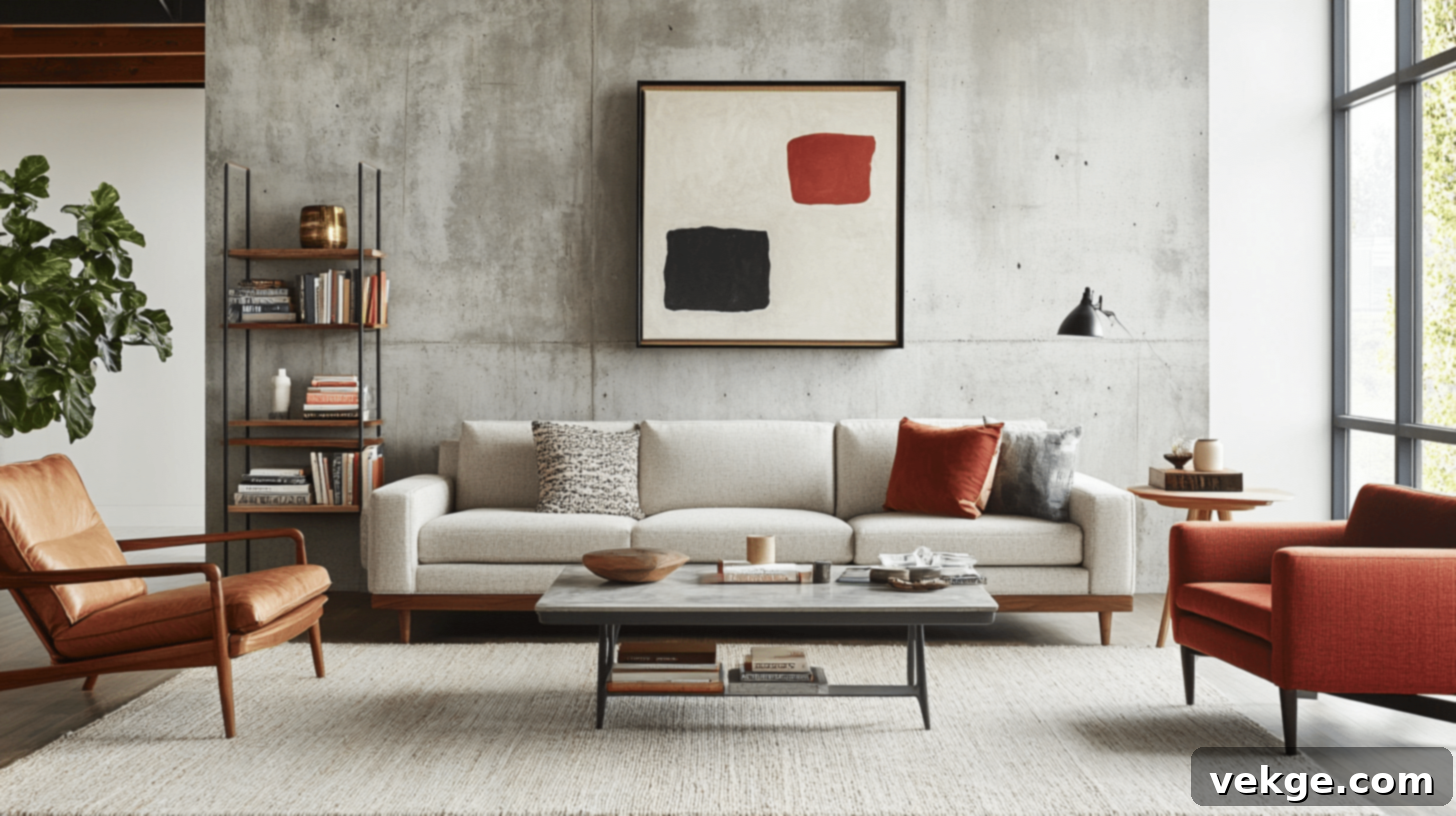
In a brutalist living room, a concrete statement wall serves as a powerful anchor, setting the raw and architectural tone. This wall can be smooth and polished for a sleek modern feel or rough and textured to showcase the concrete’s natural imperfections. Pair this with mid-century modern furniture, which often features clean lines and simple forms, offering a comfortable yet stylish complement to the brutalist aesthetic. To prevent the space from feeling too austere, thoughtfully introduce elements like oversized, abstract art, substantial books on minimalist shelving, and varied textures in throws and cushions. These personal touches add warmth and personality, making the space feel lived-in while maintaining its strong design integrity.
Kitchen Concepts
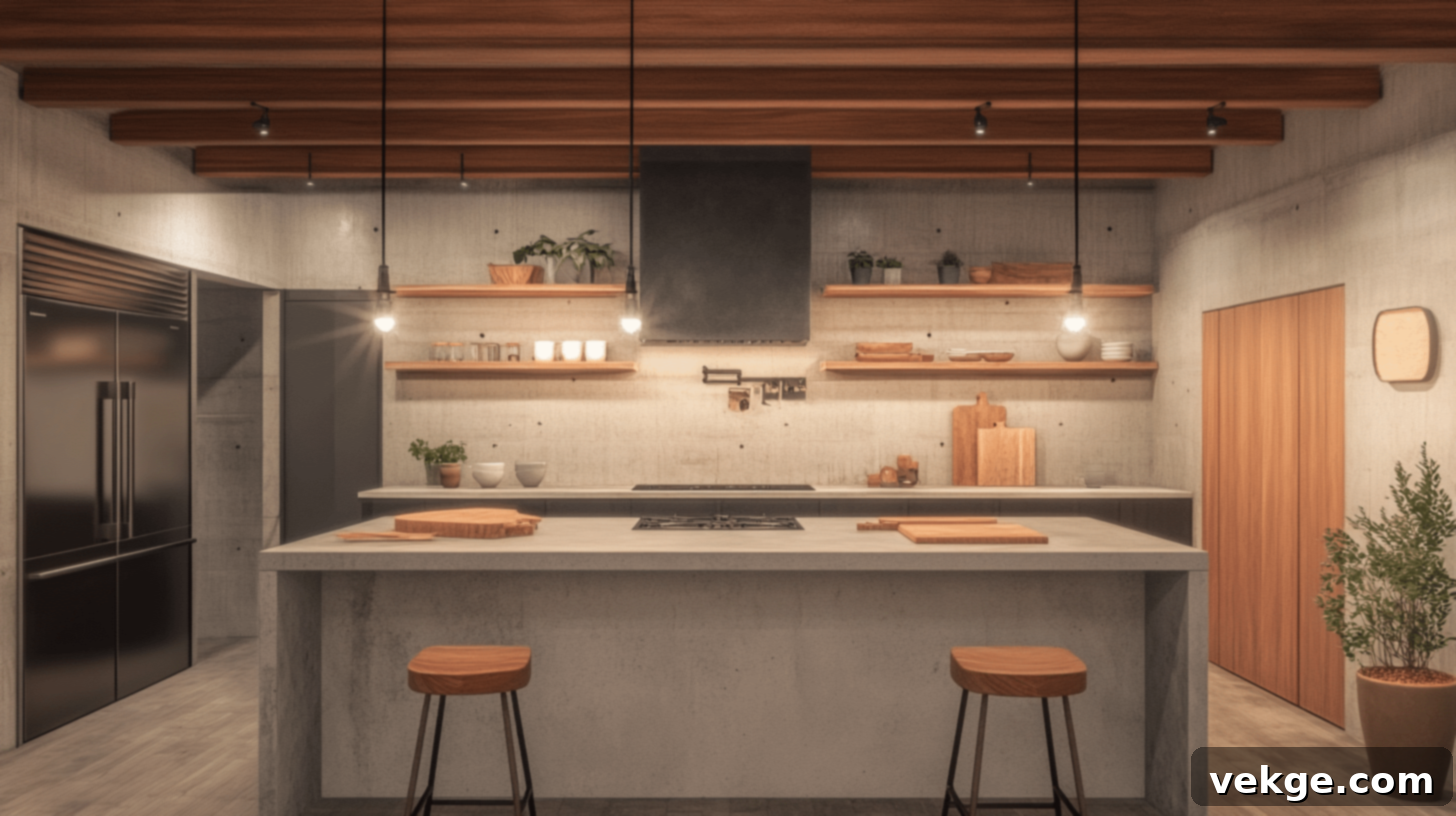
Brutalist kitchens are characterized by their bold, minimalist designs. Think substantial kitchen islands with clean, unadorned surfaces and cabinetry that emphasizes basic geometric shapes. Steel and concrete countertops and backsplashes not only offer incredible durability and hygiene but also contribute to a distinctly modern and industrial look. The raw aesthetic of these materials stands up well to daily use and offers a timeless appeal. To balance the inherent coolness and hardness of these surfaces, integrate warm woods in elements like bar stools, cutting boards, open shelving, or even exposed ceiling beams, creating a harmonious blend of raw and refined textures.
Bedroom Tips
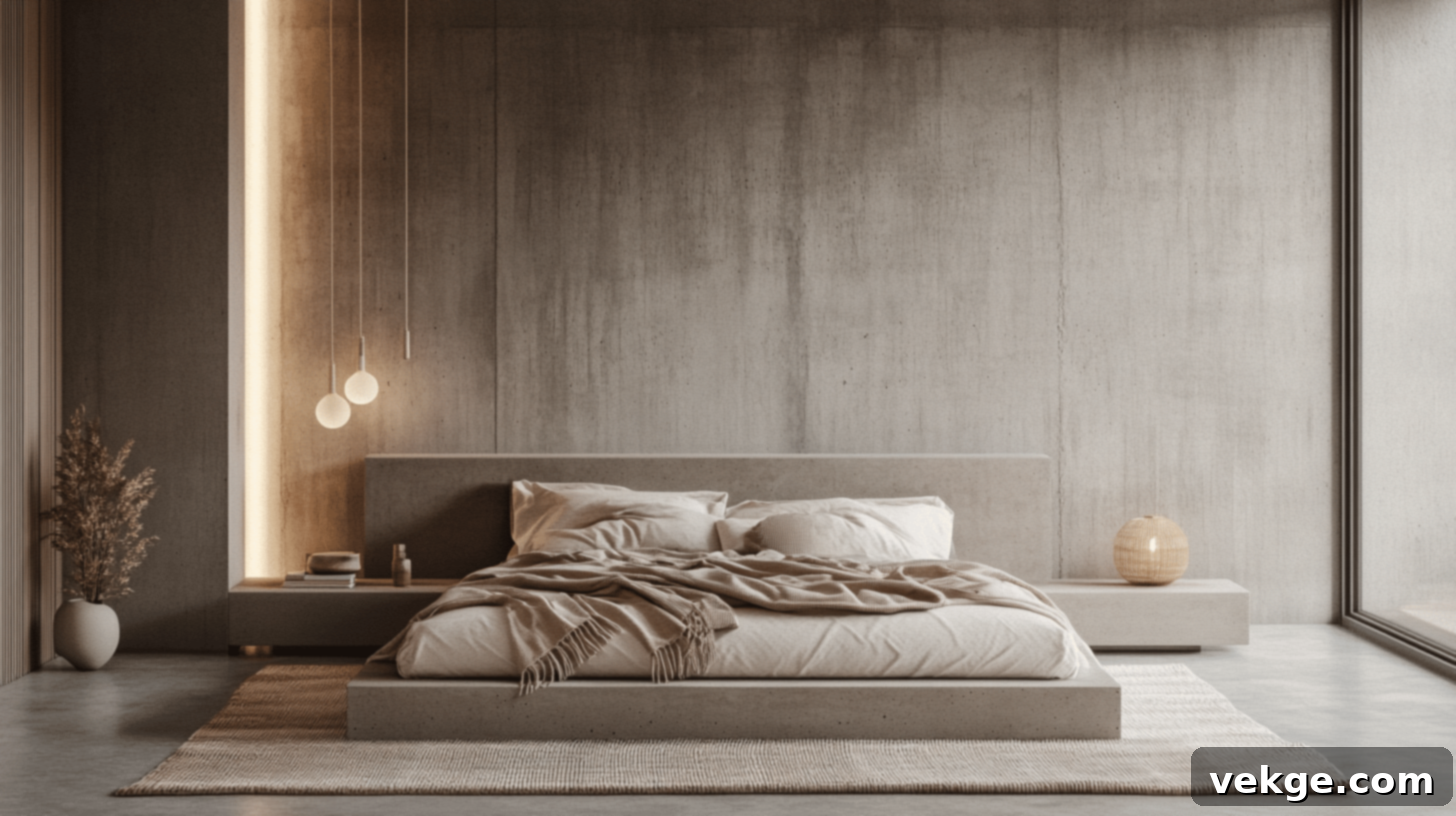
A brutalist bedroom prioritizes a minimalist layout to foster a calm and serene atmosphere. By limiting clutter and focusing on essential items with simple forms, a sense of peace and openness is achieved. To ensure the space remains a comfortable sanctuary, cozy bedding in natural fibers (like linen or organic cotton) and soft, ambient lighting are paramount. Consider a striking concrete headboard or a single concrete feature wall behind the bed to introduce the brutalist touch without making the entire room feel cold. The key is to blend the raw strength of the style with elements that promote relaxation and comfort, making it an ideal space for rest.
Why Brutalist Design Excels in Modern Homes
Beyond its striking visual appeal, brutalist design offers several compelling advantages that make it particularly suitable for contemporary living.
Lasting and Bold Aesthetic
Unlike transient trends that quickly fade, brutalist design possesses a timeless quality. Its reliance on fundamental forms and durable materials like concrete ensures that the aesthetic remains fresh and impactful for decades. The strong lines and clear architectural forms create spaces that feel inherently honest and direct, offering a powerful counterpoint to often softer, more conventional design choices. In an era of disposable design, brutalism stands out as a testament to endurance and powerful, uncompromising style.
Inherently Energy-Efficient Properties
The materials central to brutalist homes, particularly concrete, boast excellent thermal mass properties. Thick concrete walls absorb heat during the day and release it slowly at night, helping to keep interiors warm in winter and cool in summer. This natural thermal regulation can significantly reduce reliance on artificial heating and cooling systems, contributing to lower energy consumption and costs. Furthermore, the solid construction often associated with brutalism provides superior sound insulation, creating more peaceful and quiet living environments.
Promotes an Uncluttered, Mindful Aesthetic
The clean, minimalist ethos of brutalist spaces actively encourages a decluttered lifestyle. By favoring fewer, more substantial items and emphasizing integrated, simple storage solutions, rooms naturally remain more orderly and free from visual distractions. This style encourages intentional living and thoughtful consumption, asking occupants to curate their possessions carefully. The resulting open space not only makes cleaning easier but also contributes to a sense of expansive calm, fostering a more mindful and less stressful home environment.
A Perfect Canvas for Art and Greenery
The stark, unadorned background of brutalist rooms provides an exceptional backdrop for displaying art and plants. Plain concrete walls, with their muted tones and textured surfaces, make paintings, sculptures, and photographs pop with heightened intensity and focus, much like a gallery setting. Similarly, vibrant green plants create a dramatic and beautiful contrast against the cool grays of concrete and industrial metals, bringing organic life and a refreshing visual dynamic to the space. The simplicity of brutalist design allows individual special items to receive undivided attention and truly shine.
Brutalism in Small Spaces: Maximizing Impact
Thinking brutalist design is only for large, sprawling spaces? Think again. With clever execution, this powerful aesthetic can also thrive in smaller homes or apartments.
For those in smaller spaces or rentals where structural changes aren’t feasible, faux concrete wallpaper or paint offers an invaluable solution. These options allow you to achieve the distinctive brutalist look and texture on walls without the considerable weight, cost, or permanence of actual concrete construction. This is particularly effective for creating an accent wall that grounds the room without overwhelming it.
Modular furniture that can be rearranged or serve multiple functions is another strategic choice for compact brutalist interiors. Think of a concrete block that doubles as a side table and extra seating, or a minimalist steel shelving unit that provides both storage and an open visual break. This adaptability ensures functionality without sacrificing the clean, robust aesthetic.
Achieving visual balance in a small brutalist space relies on a careful interplay of neutral walls with a few carefully chosen, bold items. Let a substantial concrete lamp, a blocky wooden stool, or a striking piece of metal art be the focal points. This strategy creates visual interest and depth without making the space feel crowded or diminished, allowing the strength of the brutalist elements to stand out, even in a more confined area.
Curating Brutalist Furniture and Decor Picks
When selecting pieces for a brutalist interior, prioritize materials and forms that embody strength, honesty, and simplicity. Focus on concrete, steel, and reclaimed wood for authenticity.
- Look for solid concrete coffee tables with simple, geometric shapes. These pieces add significant visual weight and functionality while serving as a sculptural centerpiece.
- Choose steel-frame chairs or benches with minimal upholstery. The focus should be on the clean lines and exposed metalwork, often with a raw or brushed finish.
- Select open shelving units constructed from steel and concrete. These pieces not only provide storage but also highlight the exposed structural elements, a hallmark of the style.
- Add warmth and character with reclaimed wood side tables or consoles that celebrate their natural grain, imperfections, and unpolished finish.
- Consider concrete pendant lights or substantial floor lamps with exposed bulbs (especially Edison-style) to serve as statement lighting pieces that reinforce the raw, industrial vibe.
- For seating, think chunky, low-slung sofas with straight lines, possibly in durable materials like canvas, heavy linen, or leather in muted tones.
- Incorporate ceramic or stoneware planters with simple, unglazed finishes to house your greenery, complementing the raw material palette.
Pros and Cons of Brutalist Interiors
Like any distinct design style, Brutalism comes with its own set of advantages and challenges. Understanding these can help you decide if it’s the right fit for your home.
| Pros | Cons |
|---|---|
| Durable: Concrete, steel, and robust wood are exceptionally long-lasting materials, requiring minimal maintenance. | Can Feel Cold: The abundance of hard, cool surfaces may require conscious effort to soften with textiles, wood, and plants. |
| Unique & Distinctive: Brutalism is a less common style, ensuring your spaces will stand out and possess a strong, individual character. | Challenging to Modify: Permanent concrete features are difficult and costly to alter once installed, demanding careful planning. |
| Minimalist & Uncluttered: Naturally encourages a clean, open, and organized environment, promoting a sense of calm. | Potentially Expensive: High-quality, custom concrete work and substantial steel elements can be a significant investment. |
| Sculptural & Artistic: The emphasis on form and material creates spaces and objects that feel inherently artistic and architectural. | Can Feel Too Heavy: If not balanced correctly, the blocky, monolithic nature of the style can make smaller spaces feel even more confined or imposing. |
| Energy-Efficient: Concrete’s thermal mass helps regulate indoor temperatures, potentially reducing heating and cooling costs. | Perception of Unfinished: Some may find the raw, exposed nature of materials to appear unfinished or unpolished, rather than intentionally designed. |
Brutalist Design vs. Industrial Style: A Comparison
While often conflated, Brutalist and Industrial styles have distinct origins, aesthetics, and material emphases. Understanding their differences is key to achieving your desired look.
| Feature | Brutalist Design | Industrial Style |
|---|---|---|
| Origins | Post-WWII architecture (1950s-70s), philosophical emphasis on raw concrete (béton brut) and mass housing. | Adaptation of actual factories, warehouses, and urban lofts from the late 19th/early 20th centuries. |
| Main Materials | Dominantly raw concrete, unpolished steel, large expanses of glass. Sometimes untreated wood. | Exposed brick, metal pipes/ductwork, weathered wood, distressed leather, iron, copper. |
| Planning | Highly planned, geometric, and often monumental; a deliberate architectural statement. | Often appears more organic or “found,” celebrating the existing structure and utility. |
| Appearance | Ordered, exact, intentional, sculptural, and monolithic. A powerful, stark aesthetic. | More casual, lived-in, utilitarian, and raw with a sense of history and function. |
| Color Palette | Primarily grays (from concrete), white, black, with minimal, often muted, accent colors. | Rusts, browns, charcoal, black, exposed brick reds, and darker, earthy tones. |
| Surfaces | Can be smooth and polished or rough and textured (e.g., board-formed concrete), but generally clean and unadorned. | Often rough, worn, distressed, or aged; celebrates imperfections and patina. |
| Lines | Sharp, angular, deliberate, and often rectilinear, emphasizing powerful forms. | More varied, includes curved industrial elements (pipes, gears) alongside straight lines. |
| Emphasis | Form, structure, monumental presence, and the raw beauty of materials. | Function, utility, repurposed elements, and the historical narrative of a working space. |
Wrapping Up: Embracing the Enduring Appeal of Brutalism
Brutalist interior design offers a compelling and distinctive alternative to conventional home styles. Its bold shapes, celebration of raw materials, and commitment to clean, uncluttered spaces create environments that are both undeniably modern and remarkably timeless. It’s a style that speaks of strength, honesty, and a profound appreciation for fundamental forms.
You don’t need to transform your entire home into a concrete fortress to embrace this powerful aesthetic. Begin by introducing brutalist elements gradually. Start small with a sculptural concrete lamp, a robust steel bookshelf, or a chunky, unadorned wood table with simple lines. Integrate these pieces with softer textures, natural elements, and comfortable furnishings you already own. Thoughtfully placed plants, plush rugs, and warm, atmospheric lighting are essential for balancing the cool, strong character of brutalist spaces, making them both visually striking and eminently livable.
Your home can be a harmonious blend, combining the raw power and enduring appeal of brutalism with the comfort and personality that make a space truly your own. Which brutalist element will you choose to introduce first, to begin your journey into this captivating design world?
